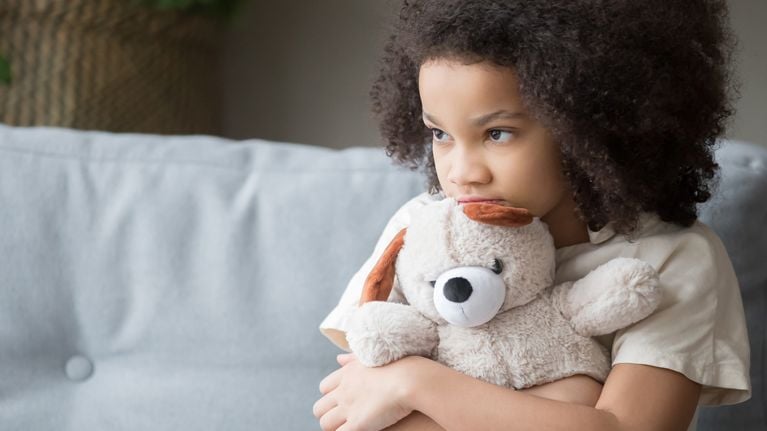Kids and Anxiety: Signs, Techniques and When to be Concerned
How to anxiety-proof your child, or at least shrink the worry
By Randi Chapnik Myers
Updated Feb 09, 2024
Wouldn’t it be wonderful if kids could just sail through life worry-free? Not going to happen. But that doesn’t stop moms and dads from fretting about their kids’ levels of anxiety. In fact, according to a recent study by Kinark Child and Family Services in Ontario, a full 70 percent of Canadian parents worry about their kids’ future emotional well-being. And they have a good reason: Anxiety disorders are the number one mental health problem in children and youth.
Let’s face it: with all the challenges of growing up — from fights with friends to sports competitions to ever-mounting homework — kids are bound to feel anxious now and then. And that’s OK: A few tummy flips right before her piano recital help your child to focus and the increased adrenalin can enhance her performance. It’s only when those anxious feelings become too intense or occur too often that we need to step in and help. Here’s how to do just that.
Spot the signs
“Anxiety becomes a problem when it interferes with your child’s sleep and daily activities, like school work or playing with friends,” says Jennifer Kolari, a Toronto child and family therapist and founder of Connected Parenting. If that’s happening, she says it’s time to identify the signs of your child’s distress — fast breathing, a heaviness in her chest, clinginess, unexplained tummy aches — so she can learn to control it before it controls her.
You have to catch these signs before they escalate into real panic, Kolari says because at that point, you can’t talk your child out of it. “Once the fight-or-flight instinct kicks in, her thinking gates close, and she can’t hear logic.” While she may know that a monster can’t possibly be under her bed, in panic mode, she can’t control “trick thoughts” that convince her she’s in danger.
So, what exactly is pushing your child’s panic button? That fear can stem from being alone to speaking in front of a group to being hurt by the dentist’s drill. To help her work through her anxiety, you have to start by pinpointing the trigger, Kolari says. And once you do, don’t try to hide it from your child. “Surprising her with a trip to the dentist will only make the panic worse,” she says.
Listen, then talk
A better route: Let your child get used to facing his fear by bringing it into the open and discussing it. “When your child is anxious, look into his eyes and listen,” Kolari says. Then, he mirrors his feelings in a calm but urgent tone: “That party looks like a lot of fun, and part of you wants to go, but the worries are getting in the way.” When your child feels validated, the fear will start to recede, she says, and his mind will open to logic.
To help your child talk about his anxiety, Kolari suggests giving it a name, like “the worries” or “the worry bug.” Now, rather than being a dreaded part of himself, his fear is an entity you can work together to reduce. So when you’re on the way to the baseball game, and you sense he’s getting anxious, you can check in with him by asking: “Are the worries in the way again?”

Teach techniques
Ultimately, you want your child to recognize her anxiety so she can calm herself down. Try these steps.
- Start by teaching her to listen to her body, Kolari says. Since kids often mistake fear for sickness, ask how her body tells her she is nervous. Does she get a headache? Nausea? Clenched fists? A racing heart? Difficulty breathing? If she can spot the symptoms, she won’t freak out the next time she feels them.
- Teach her to do exercises like positive imagery (where she thinks about a favourite food, vacation or friend), or to concentrate on slow, deep breathing, Kolari suggests. “Give your child a sense of control by telling her those breaths are a magic wind that shrinks the worry bug.” Or show her that by just holding her hand on her heart, she can feel it start to slow.
- To help your child monitor her anxiety level, ask her to rate it on a scale from one to 10. If the number is too high — say six or seven — suggest she try a calming technique to lower it. “This scaling exercise gives kids confidence,” Kolari says. “Suddenly, they see that they are stronger than their fears.”
Cause for concern
Is your child too anxious? Consider getting some outside help if you see these telltale signs:
- insomnia
- stomach aches, headaches or vomiting
- racing heart, shortness of breath
- resistance to participating in social activities, such as parties or sleepovers
- fear of deviation from regular routine
- excessive fear before school or babysitting time
- tantrums right before a specific event
- exaggerated negative thoughts about future events
- ultra-clinginess, constant crying
Weekly Newsletter
Keep up with your baby's development, get the latest parenting content and receive special offers from our partners